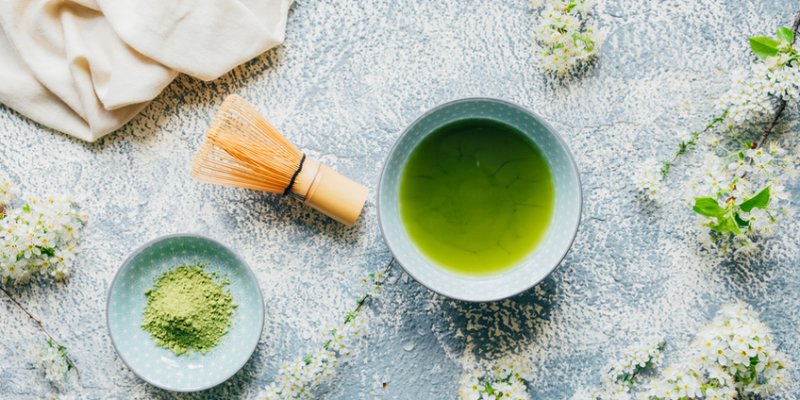 Camellia sinensis, Chinese tea, Matsucha
Camellia sinensis, Chinese tea, Matsucha
Green tea is prepared from the steamed and dried leaves of Camellia sinensis. (By comparison, black tea leaves are withered, rolled, fermented, and then dried.) Green tea contains the polyphenolsepigallocatechin and epigallocatechin-3-gallate, some of the most potent anti carcinogenic substances found in nature.
Green tea’s antioxidant activity and its ability to inhibit cell proliferation and induce apoptosis are what give it its anticarcinogenic effects. The caffeine can have stimulatory effects on central nervous system (CNS). The tannins have astringent properties, which provide an antidiarrheal effect. Green tea may also decrease serum cholesterol levels and have antibacterial properties. It’s less popular in America and Europe than black tea.
Green tea is available as capsules, dried extract, liquid, tablets, and teas Common trade names include Chinese Green Tea ags, Green Tea Extract, Green Tea Power, Green Tea Power Caffeine Free, and Standardized Green Tea Extract.
Reported uses
As per report by Ceraonline, Green tea is used to prevent cancer, hyperlipidemia, atherosclerosis, dental caries, and headaches, and to treat wounds, skin disorders, stomach disorders, and infectious diarrhea. It’s also used as a CNS stimulant, a mild diuretic, an antibacterial and, topically, as an astringent.
Administration
A typical daily dose is 300 to 400 mg of polyphenols (3 cups of green tea contain 240 to 320 mg of polyphenols).
Hazards
Adverse effects associated with green tea include nervousness, insomnia, tachycardia, hyperacidity, GI irritation, decreased appetite, constipation, diarrhea, increased blood glucose and cholesterol levels, asthma, and allergic reactions. Increased stimulatory effects may be seen when administered with ephedrine or any drug that acts as a stimulant because of the caffeine component. Administration with warfarin may lead to a decreased INR. Simultaneous use of green tea and iron supplementation reduce the absorption of iron.
Patients allergic to green tea and breast-feeding patients should avoid use. Green tea shouldn’t be used in infants or small children. Pregnant women should avoid or minimize use because of the caffeine. Patients with cardiovascular or renal disease, hyperthyroidism, spasms, and psychic disorders should use with caution.
Clinical considerations
- Dosage varies with the form of the herb.
- Advise patient to look for products standardized to 80% polyphenol and 55% epigallocatechingallate.
- Daily consumption should be limited to fewer than 5 cups, or the equivalent of 300 mg of caffeine, per day to avoid the adverse effects of caffeine.
- Advise patient that heavy consumption may be associated with esophageal cancer secondary to the tannin content in the mixture.
- Prolonged high caffeine intake may cause restlessness, irritability, insomnia, palpitations, vertigo, headache, and adverse GI effects. Monitor patient’s intake.
- The adverse GI ,effects of chlorogenic acid and tannin can be avoided if milk is added to the tea mixture.
- The tannin content in tea increases the longer it’s left to brew; this increases the antidiarrheal properties of the tea.
- In children, administering green tea with iron supplements or multivitamins with iron prevents the absorption of iron.
- The first signs of a toxic reaction are vomiting and abdominal spasm.
- Black tea is made from the same resources of green tea but fermented to allow oxidation of polyphenols. The antioxidant activity of green tea is six times greater than black tea. For antitumor, antioxidant, or dental caries prevention, black tea cannot be used interchangably.
- Advise patient to consult his health care provider before using an herbal preparation because a conventional treatment with proven efficacy may be available.
- Tell patient to notify pharmacist of any herbal or dietary supplement that he’s taking when obtaining a new prescription.
Research summary
The literature regarding green tea and its components is extensive. Preliminary studies indicate that green tea exerts a chemoprotective effect that may contribute to a reduced incidence of cancer and other life-threatening diseases. However, these data are derived from epidemiologic studies that require confirmation.
Green tea’s antitumor activities are reported frequently in the literature. Case control studies indicate that green tea consumption is negatively associated with incidence and recurrence of colon cancer, pancreatic cancer, rectal cancer, and breast cancer. In a cohort study, the consumption of extract of green tea that contains polyphenols is associated with significant inhibition of plaque deposition and lower serum cholesterol. The antioxidant activity of green tea extract may be used to prevent ischemic stroke. Green tea is recommended to aid weight reduction. For patients on warfarin therapy, green tea consumption will significantly decrease INR due to its high vitamin K content.

